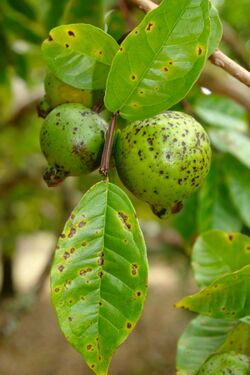Biology:Cephaleuros virescens
| Cephaleuros virescens | |
|---|---|

| |
| Cephaleuros virescens as a parasite of guava leaves and fruit in Hawaii, causing a leaf and fruit spot disease | |
| Scientific classification | |
| (unranked): | Viridiplantae |
| Division: | Chlorophyta |
| Class: | Ulvophyceae |
| Order: | Trentepohliales |
| Family: | Trentepohliaceae |
| Genus: | Cephaleuros |
| Species: | C. virescens
|
| Binomial name | |
| Cephaleuros virescens Kunze ex E.M.Fries 1832: 327
| |
| Synonyms | |
|
Cephaleuros parasiticus | |
Cephaleuros virescens is an algal plant pathogen[1] that infects tea, coffee and coconut plants, causing algal leaf spot or algal rust.[2][3]
Host and symptoms
Cephaleuros virescens is known to have a broad host range,[2] the widest host range of the species. It has been recorded on 287[2] plant species and cultivars on the U.S. Gulf coast alone. Common hosts of the plant include tropical trees and shrubs, with the following being the more common or economically important; tea, kava, pepper, para rubber, magnolia, coffee, holly, Indian hawthorn, oil palm, avocado, vanilla, mango, breadfruit, guava, coconut, cashews, cacao, citrus, etc.[2][4][5][6]
Most commonly Cephaleuros virescens is identified by the leaf spots it causes. Theses leaf spots are an orange-brown rust in color and usually occur entirely on the upper leaf surface, although leaf spots on the undersides of infected leaves have been reported. The spots are fuzzy in texture and approximately 2 cm (0.8 in) in diameter.[2] In some cases, commonly in more susceptible hosts, stem and fruit spots can occur as a result of infection as well. These leaf spots cause a reduction in plant photosynthetic surface area. While usually harmless, severe causes of these leaf spots can lead to defoliation, twig dieback, tissue necrosis, and loss of marketable fruit.[2]
Life cycle
Although both a sexual and an asexual form of reproduction occur, the asexual stage is considered to be important due to it being the more common mode 9k of inoculum in the pathogen’s disease cycle. Infection occurs when either the sporangia or thallus filaments are deposited on the tissues of a susceptible plant host. The pathogen is usually dispersed through water or wind.[6] Under the right environmental conditions, zoospores are released from the sporangia, and symptoms will begin to develop. The zoospores are able to penetrate the host cuticle in a haustorial manner. A flat, circular thallus develops subcuticularly. Algal filaments extend from these thalli further increasing the surface area this pathogen infects. The pathogen survives on existing leaf and stems as spores, and in fallen plant debris. As the pathogen lives in tropical climates it is able to survive year-round rather than relying on survival structures.[2]
Environment
As this plant pathogen is an algal species, it thrives under similar conditions as other algal organisms. Cephaleuros virescens prefers moist, humid weather. Areas with frequent rain, and warm to high temperatures are where this pathogen flourishes. It has been recorded in all continents with tropical and sub-tropical environments. It is commonly seen in Hawaii and Florida, but there has also been recorded incidents of the disease in India and Thailand.[1][3]
Management
Often, leaf spot caused by Cephaleuros virescens is not damaging enough to the host plant’s vigor or crop yield and therefore generally does not warrant management. If however the crop is highly susceptible, a form of integrated pest management can be used to prevent the spread and infection of the disease. This includes sanitation and pruning of infected plant parts. Since lower branches are usually infected, make sure to remove them as well as any debris that has littered the ground below the infected plant.[6] Reducing humidity or increasing air flow can also help, as the pathogen is most successful in moist, humid environments. Keep the plant or crop in a sunny, aerated, well-drained area. Selecting for a tolerant variety of plant, and if needed, intercropping, can reduce the rate of infection. If needed copper fungicides may assist but would need to be applied every two weeks if the environment remains wet.[6]
Importance
Although the plant pathogen is commonly mild enough to not cause serious effects to crop vigor and yield, in susceptible plants it can cause significant damage. Most commonly, economically detrimental infections occur in guava.[2] Guava is considered to be a susceptible host, and the leaf spot symptoms can grow to be severe enough to reduce plant vigor and cause defoliation. In guava, Cephaleuros virescens can cause fruit spots as well, leading to a reduction in crop yield.[citation needed]
References
- ↑ 1.0 1.1 Pitaloka, Mutiara K.; Petcharat, Vasun; Arikit, Siwaret; Sunpapao, Anurag (30 January 2015). "Cephaleuros virescens, the cause of an algal leaf spot on Para rubber in Thailand". Australasian Plant Disease Notes 10 (1). doi:10.1007/s13314-015-0158-1.
- ↑ 2.0 2.1 2.2 2.3 2.4 2.5 2.6 2.7 Nelson, Scot C. (August 2008). "Cephaleuros Species, the Plant-Parasitic Green Algae". Plant Disease (University of Hawai'i at Manoa, College of Tropical Agriculutre and Human Resources). PD-43. https://www.ctahr.hawaii.edu/oc/freepubs/pdf/PD-43.pdf.
- ↑ 3.0 3.1 Muthukumar, Thangavelu; Uma, Eswaranpillai; Priyadharsini, Perumalsamy (2 February 2015). "Occurrence of Foliicolous Parasitic Alga Cephaleuros Virescens on Cultivated Ornamental Plants in Southern India". Botanica Lithuanica 20 (2): 87–98. doi:10.2478/botlit-2014-0012.
- ↑ Vasconcelos, Camila Vilela; Pereira, Fabiola Teodoro; Duarte, Elizabeth Amelia Alves; Santos de Oliveira, Thiago Alves; Peixoto, Nei; Carvalho, Daniel Diego Costa (June 2018). "Physiological and Molecular Characterization of Cephaleuros virescens Occurring in Mango Trees". The Plant Pathology Journal 34 (3): 157–162. doi:10.5423/PPJ.OA.09.2017.0194. PMID 29887771.
- ↑ Guiry, M.D.; Guiry, G.M., "Cephaleuros virescens", AlgaeBase (World-wide electronic publication, National University of Ireland, Galway), https://www.algaebase.org/search/species/detail/?species_id=28030.
- ↑ 6.0 6.1 6.2 6.3 McLeod Scott, Janet; Williamson, Joey (23 January 2017). "Algal Leaf Spot". Home & Garden Information Center. https://hgic.clemson.edu/factsheet/algal-leaf-spot/.
Wikidata ☰ Q5063261 entry
 |

